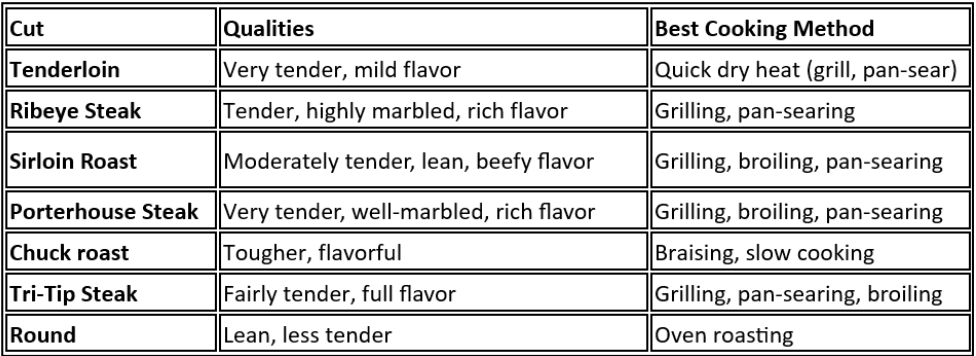Picture a scene where a rancher and his family walk into a restaurant, get situated, then after perusing the menu decide on steaks all around. When they arrive, they look great—good size, adequate thickness, a nice char. Then the unthinkable happens:
“Y’all need steak sauce with your meal?” the waitress quips.
The place goes quiet. A fork drops. Muffled gasps. Crickets stop chirping.
The rancher says, “Ma’am, if these steaks are any good, I won’t need it.”
Truer words were never spoken. Crisis averted. Grateful customers go back to their meals.
So what makes that beef any good, or at least better than other beef? There are technical aspects and just personal preference. As for the technical, here’s what makes premium beef better:
Marbling: It’s a big one. There’s a lot that goes into making marbling, including breed of the animal, its nutrition, processing, age, etc. When it comes to beef, quality grades are all about marbling, which are flecks of fat within the meat that adds tenderness, juiciness, and flavor.
For consumers, the three most common USDA grades are:
- Select: Leaner and lower marbling. It’s often more affordable, but may be less tender and flavorful.
- Choice: Moderately marbled, offering a good balance of taste and tenderness. It’s a popular pick for everyday meals.
- Prime: Highest level of marbling, making it the most tender and richly flavored. Often reserved for premium cuts at restaurants, high-end retailers, or for a tasty treat at home.
Tenderness: According to the USDA, tenderness is all about how easily you can cut or chew a piece of meat, measured by how much effort it takes to slice through it. While the breed, marbling and age of the animal affect tenderness, how the steak is prepared goes a long way, too. For a steak that’s tender and juicy, avoid overcooking it. A meat thermometer makes it easy, just cook it to your preferred doneness and you’re golden.
Flavor: It’s in the mouth of the beholder. Flavor is a combination of a few things: marbling, genetics of the animal, and what it eats. Different feedstuffs change the fatty acid composition of the animal and, due to that, change the flavor. Age has an effect, too. Older animals often have a more intense, complex, and beefy flavor. This is partly due to the accumulation of fat and the breakdown of muscle proteins during aging. Animals that were raised mostly on grass have a more intense and complex flavor profile compared to other cuts of meat. Those that were raised mostly on grain have a more conventional taste consumers are accustomed to enjoying.
The cut of meat makes a difference, too. If you’re looking for tenderness, go with a cut of meat that hasn’t done much work during the life of the animal. Tenderloins, for example, come from the loin and are a supportive muscle, meaning they don’t do anything strenuous, so they’re the most tender (hence the name). Some cuts have more marbling, like a ribeye, making them an optimal choice for a consistently juicy and tender steak.
Not all cuts are the same, so you shouldn’t cook them the same either. Here’s a table to use as a guide:

Maybe the best endorsement of a cut of beef comes from the ranchers who raise it.
“Our favorite cut of beef is a ribeye, straight off the grill,” says Jared Brackett, a Country Natural Beef member with a ranch in Southwest Idaho. “Probably the most underappreciated cut is a tri-tip. It’s tender and flavorful, and we cook that right on the grill, too.”
Anna Lickley and her family are also Country Natural Beef cooperative members who ranch in Idaho. While her favorite cut is a porterhouse made on the grill, she says the most underrated cuts of beef are roasts.
“Roasts are so versatile and hearty,” says Anna. “I made a rump roast the other day that turned out great. I started with a mustard and spice rub, then smoked it at 225 degrees until the internal temperature reached 135 degrees. Then I wrapped it in foil and let it sit in a cooler for an hour. We sliced it and served it with roasted veggies!”
Anna Lickley’s Spice Rub Recipe
Ingredients: 
Garlic, Oregano, Thyme, Rosemary, Onion Powder, Garlic Powder, Salt, Pepper
Instructions:
- Mix dry ingredients to taste preference.
- Coat meat with thin layer of Dijon mustard and generously sprinkle rub on top.
- Cook meat as desired. According to USDA guidelines, steaks, chops and roasts should be cooked to a minimum internal temperature of 145°F as measured with a food thermometer and allowed to rest before serving.
- Enjoy!
Raising high-quality beef that is well marbled, tender and flavorful takes a commitment to raising animals the right way. Our cattle are raised and finished on pasture in harmony with the land. Cattle are handled with care—no hormones or antibiotics are ever used and only vegetarian products are fed. The way our cattle are raised and how we feed them creates beef with a more intense and complex flavor, resulting in Choice and Prime grades. And our cooperative of family ranchers works hard and takes great pride in delivering the best to your table. That’s why Country Natural Beef is so good.
No steak sauce needed.
